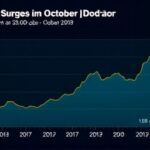In a sobering address to financial leaders, renowned investor Scott Bessent has raised alarms about the fragility of the U.S. economy, suggesting that certain sectors may already be mired in a Recession while high interest rates continue to stifle growth. Speaking at a recent economic forum, Bessent emphasized the urgent need for the Federal Reserve to implement further rate cuts to prevent a full-blown economic downturn.
- Bessent Spotlights Manufacturing and Housing as Recession Hotspots
- Persistent High Interest Rates Fueling Broader Economic Strain
- Urgent Plea for Federal Reserve Rate Cuts to Avert Downturn
- Market Volatility and Investor Sentiments in Response to Warnings
- Policy Pathways and Future Outlook for U.S. Economic Resilience
Bessent, the founder of Key Square Group and a vocal commentator on macroeconomic trends, painted a picture of an economy under strain. ‘We are seeing the early signs of contraction in key areas, and if policymakers don’t act decisively, the U.S. economy could slip into a broader Recession,’ he stated, underscoring the disconnect between official data and on-the-ground realities faced by businesses and consumers.
Bessent Spotlights Manufacturing and Housing as Recession Hotspots
Delving into specifics, Bessent pointed to the manufacturing and housing sectors as prime examples of areas already experiencing recession-like conditions. According to recent data from the Institute for Supply Management (ISM), the manufacturing PMI has hovered below 50 for several consecutive months, indicating contraction. In August 2023, the index stood at 47.6, reflecting ongoing declines in new orders and production.
‘The manufacturing sector is not just slowing; it’s contracting at a pace reminiscent of the early stages of past recessions,’ Bessent noted during his speech. He attributed this partly to elevated interest rates, which have made borrowing for capital investments prohibitively expensive for many firms. The Federal Reserve’s benchmark rate, maintained at 5.25-5.50% since July 2023, has ripple effects across supply chains, squeezing margins and delaying expansions.
In the housing market, the impact is even more pronounced. Home sales have plummeted to their lowest levels in decades, with existing-home sales dropping 18.1% year-over-year in July 2023, per the National Association of Realtors. Mortgage rates, influenced directly by the Fed’s interest rates, have surged above 7%, locking out first-time buyers and cooling construction activity. Bessent warned that this stagnation could lead to job losses in related industries, amplifying the risk of a wider economic downturn in the U.S. economy.
To illustrate, Bessent referenced a report from the U.S. Census Bureau showing a 10.5% decline in building permits for single-family homes in the first half of 2023 compared to the previous year. ‘When housing falters, it drags down consumer spending and employment—two pillars of our economy,’ he said, urging immediate intervention.
Persistent High Interest Rates Fueling Broader Economic Strain
The crux of Bessent’s caution lies in the prolonged elevation of interest rates, a policy tool wielded by the Federal Reserve to combat inflation but now posing risks to growth. Since initiating its aggressive hiking cycle in March 2022, the Fed has raised rates by over 5 percentage points, the fastest pace in modern history. While inflation has cooled from its 9.1% peak in June 2022 to around 3.7% as of September 2023, per the Consumer Price Index, the collateral damage to the U.S. economy is mounting.
Bessent argued that the Fed’s reluctance to pivot sooner has exacerbated vulnerabilities. ‘High interest rates are like a tourniquet on the economy—they stop the bleeding from inflation but risk cutting off circulation entirely,’ he analogized. This sentiment echoes concerns from other economists; a survey by the National Association for Business Economics in late 2023 found that 72% of respondents believe the U.S. is at risk of recession within the next year if rates remain elevated.
Consumer debt is another flashpoint. Household debt reached a record $17.5 trillion in Q2 2023, according to the Federal Reserve Bank of New York, with credit card balances surging 10.9% year-over-year. Elevated interest rates have pushed average credit card APRs to over 21%, straining family budgets and potentially curbing discretionary spending—a key driver of the U.S. economy, which relies on consumer activity for nearly 70% of GDP.
- Key Statistic: Delinquency rates on consumer loans rose to 3.2% in Q2 2023, the highest since 2012.
- Expert Quote: ‘The lag effects of tight monetary policy are hitting harder than anticipated,’ said Mark Zandi, chief economist at Moody’s Analytics, aligning with Bessent’s views.
Bessent’s analysis extends to corporate America, where high borrowing costs have led to a slowdown in mergers and acquisitions. Deal volume in 2023 is down 30% from 2022 peaks, per Dealogic data, as firms hoard cash amid uncertainty.
Urgent Plea for Federal Reserve Rate Cuts to Avert Downturn
In response to these pressures, Bessent made a direct appeal for the Federal Reserve to accelerate interest rate reductions. He advocated for cuts totaling at least 75 basis points by the end of 2023, starting with a 50-basis-point slash at the upcoming FOMC meeting. ‘The data screams for relief; delaying action only invites a deeper economic downturn,’ he asserted.
This call comes amid mixed signals from Fed Chair Jerome Powell, who in his Jackson Hole speech in August 2023 signaled a data-dependent approach but stopped short of committing to immediate cuts. Market futures, however, are pricing in a 85% chance of a 25-basis-point cut in November 2023, according to CME FedWatch Tool, reflecting growing expectations influenced by voices like Bessent’s.
Bessent drew historical parallels to the 2001 dot-com bust and the 2008 financial crisis, where timely rate adjustments mitigated damage. ‘In both cases, the Fed’s pivot prevented a recession from becoming a depression. We need that wisdom now,’ he said. Supporting his argument, he cited the Atlanta Fed’s GDPNow model, which recently revised Q3 2023 growth estimates downward to 1.2% annualized, a far cry from the robust expansion needed to outpace demographic trends.
Small businesses, often the backbone of the U.S. economy, are particularly vulnerable. A survey by the National Federation of Independent Business in September 2023 revealed that 45% of owners cited high interest rates as their top concern, up from 32% earlier in the year. Bessent highlighted how this could lead to widespread layoffs, with unemployment potentially rising from its current 3.8% to over 5% if a recession materializes.
Market Volatility and Investor Sentiments in Response to Warnings
Bessent’s remarks have already stirred ripples in financial markets, contributing to heightened volatility. The S&P 500 experienced a 1.2% dip in the days following his speech, as investors reassess recession probabilities. The VIX fear index spiked to 18.5, its highest in three months, signaling unease about the trajectory of the U.S. economy.
Wall Street analysts are divided. Optimists like those at Goldman Sachs maintain a ‘soft landing’ scenario, projecting 2.5% GDP growth in 2024 with gradual rate cuts. Pessimists, including Bessent, foresee a 40% chance of contraction, per Bloomberg consensus. ‘Bessent’s warning is a wake-up call; markets can’t ignore the undercurrents forever,’ commented Jim Cramer on CNBC, echoing the broader debate.
Bond yields have also reacted, with the 10-year Treasury dipping to 4.2% post-speech, as traders bet on impending Fed easing. This shift could provide some relief to rate-sensitive sectors but underscores the precarious balance policymakers must strike to avoid an economic downturn.
- Immediate Market Impact: Dow Jones Industrial Average fell 250 points on the announcement day.
- Longer-Term View: Hedge funds, including Bessent’s own, are positioning for defensive plays, increasing allocations to utilities and consumer staples.
- Global Echoes: European and Asian markets showed sympathy declines, highlighting interconnected risks.
Consumer confidence indices further validate the concerns. The Conference Board’s index dropped to 103.2 in September 2023, with expectations subindex hitting a nine-month low, as households brace for higher costs and potential job insecurity amid persistent interest rates.
Policy Pathways and Future Outlook for U.S. Economic Resilience
Looking ahead, Bessent’s intervention spotlights the critical juncture for U.S. economic policy. If the Federal Reserve heeds calls for rate cuts, it could inject vitality into the U.S. economy, potentially averting a recession. Projections from the Congressional Budget Office suggest that a 100-basis-point reduction could boost GDP by 0.5% over the next two years, while also easing pressure on the labor market.
However, challenges persist. Inflation remains sticky in services, with core PCE at 2.7% in August 2023, complicating the Fed’s dual mandate. Bessent advocated for a balanced approach, combining monetary easing with fiscal measures like targeted infrastructure spending to support vulnerable sectors.
The implications extend beyond borders; a U.S. economic downturn could dampen global trade, affecting exports from manufacturing powerhouses like China and Germany. Domestically, policymakers in Congress are eyeing stimulus options, though partisan divides may hinder swift action.
As the Fed’s next meeting approaches, all eyes will be on incoming data—employment reports, inflation readings, and GDP revisions—that could sway the decision on interest rates. Bessent concluded optimistically: ‘With proactive steps, we can steer clear of the abyss and foster sustainable growth.’ Yet, the path forward demands vigilance, as the U.S. economy navigates this high-stakes environment.
In the coming months, quarterly earnings from major corporations will provide further clues. Companies in tech and finance, less burdened by debt, may weather the storm better than industrials. Investors are advised to monitor leading indicators like the yield curve, which remains inverted—a classic harbinger of recession—now in its 18th month.
Ultimately, Bessent’s warning serves as a catalyst for debate, potentially influencing not just Fed policy but also electoral dynamics in 2024, where economic health will be paramount. By addressing these risks head-on, the U.S. can position itself for a resilient recovery, turning potential peril into opportunity.









